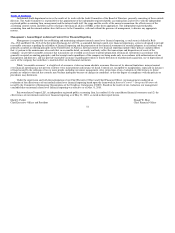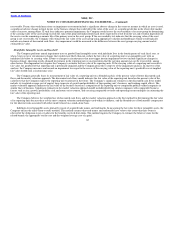Nike 2010 Annual Report Download - page 64
Download and view the complete annual report
Please find page 64 of the 2010 Nike annual report below. You can navigate through the pages in the report by either clicking on the pages listed below, or by using the keyword search tool below to find specific information within the annual report.
Table of Contents NIKE, INC.
NOTES TO CONSOLIDATED FINANCIAL STATEMENTS — (Continued)
Cash and Equivalents
Cash and equivalents represent cash and short−term, highly liquid investments with maturities of three months or less at date of purchase. The
carrying amounts reflected in the consolidated balance sheet for cash and equivalents approximate fair value.
Short−term Investments
Short−term investments consist of highly liquid investments, primarily commercial paper, U.S. treasury, U.S. agency, and corporate debt securities,
with maturities over three months from the date of purchase. Debt securities that the Company has the ability and positive intent to hold to maturity are
carried at amortized cost. At May 31, 2010 and 2009, the Company did not hold any short−term investments that were classified as held−to−maturity.
At May 31, 2010 and 2009, short−term investments consisted of available−for−sale securities. Available−for−sale securities are recorded at fair value
with unrealized gains and losses reported, net of tax, in other comprehensive income, unless unrealized losses are determined to be other than temporary.
The Company considers all available−for−sale securities, including those with maturity dates beyond 12 months, as available to support current operational
liquidity needs and therefore classifies all securities with maturity dates beyond three months as current assets within short−term investments on the
consolidated balance sheet.
See Note 6 — Fair Value Measurements for more information on the Company’s short term investments.
Allowance for Uncollectible Accounts Receivable
Accounts receivable consists primarily of amounts receivable from customers. We make ongoing estimates relating to the collectability of our
accounts receivable and maintain an allowance for estimated losses resulting from the inability of our customers to make required payments. In determining
the amount of the allowance, we consider our historical level of credit losses and make judgments about the creditworthiness of significant customers based
on ongoing credit evaluations. Accounts receivable with anticipated collection dates greater than 12 months from the balance sheet date and related
allowances are considered non−current and recorded in other assets. The allowance for uncollectible accounts receivable was $116.7 million and $110.8
million at May 31, 2010 and 2009, respectively, of which $43.1 million and $36.9 million was classified as long−term and recorded in other assets.
Inventory Valuation
Inventories are stated at lower of cost or market and valued on a first−in, first−out (“FIFO”) or moving average cost basis.
Property, Plant and Equipment and Depreciation
Property, plant and equipment are recorded at cost. Depreciation for financial reporting purposes is determined on a straight−line basis for buildings
and leasehold improvements over 2 to 40 years and for machinery and equipment over 2 to 15 years. Computer software (including, in some cases, the cost
of internal labor) is depreciated on a straight−line basis over 3 to 10 years.
Impairment of Long−Lived Assets
The Company reviews the carrying value of long−lived assets or asset groups to be used in operations whenever events or changes in circumstances
indicate that the carrying amount of the assets might not be
61
























